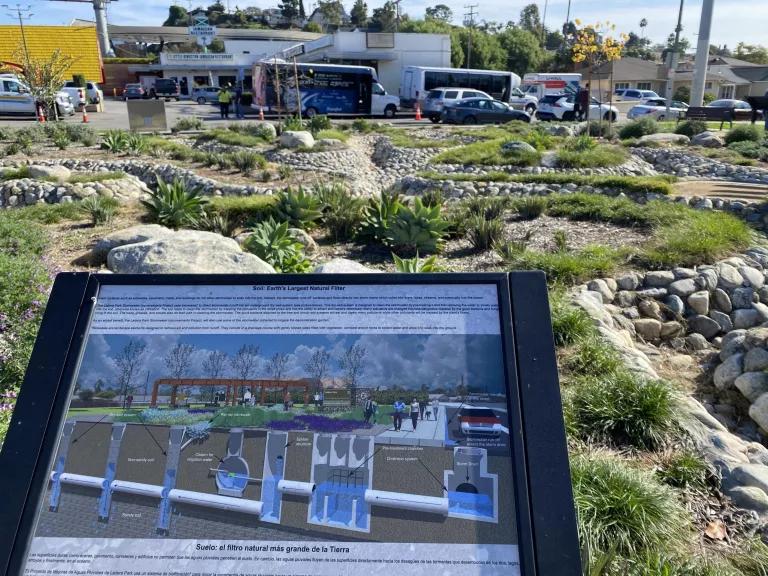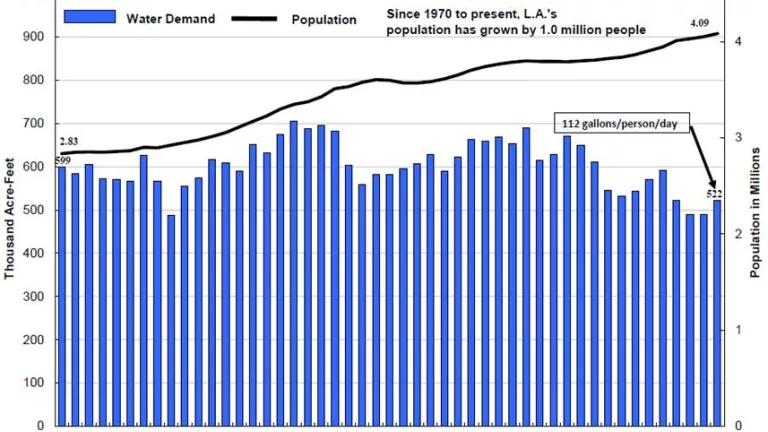Drought-Proofing Los Angeles County
L.A. County releases an ambitious new plan to switch to 80 percent local water to address increasing droughts from climate change.

Ladera Park Stormwater Improvements Project
Heal the Bay
This week has been big for water resilience in Los Angeles County. On December 5, the Board of Supervisors approved a comprehensive L.A. County Water Plan that highlights the need and approaches to achieve 80 percent local water supplies by 2045.
The new target comes from the OurCounty sustainability plan that was approved in 2019. Currently, only about 40 percent of L.A. County’s water supplies comes from local sources such as groundwater and recycled water, while the city of LA is currently at about 20 percent local water. The vulnerability of regional and imported water supplies was exposed during the two major droughts we’ve experienced over the past decade. These events have demonstrated that L.A. County cannot achieve water and climate resilience without a rapid, transformative move toward local water self-sufficiency.
L.A. County Water Plan and Board of Supervisors Chair Lindsey Horvath highlighted the need for the county to find 600,000 acre-feet per year (more than the city of Los Angeles uses annually) of new local water from water recycling, stormwater capture, cleaning up polluted aquifers, and other conservation measures to meet the ambitious local water target. In addition, the L.A. County Water Plan included:
- recommendations to restore flood control basin storage capacity through sediment removal and, ideally, the beneficial use of those sediments for purposes like beach replenishment;
- groundwater and surface water quality improvements;
- an equity-based approach to ensure that all county residents have access to safe, affordable, and reliable water supplies.
Horvath also set 2024 requirements to focus on implementation of various aspects of the county water plan.
On December 7, NRDC, Heal the Bay and the Los Angeles Waterkeeper released Vision 2045: Thriving in a Hotter and Drier L.A. County Through Local Stormwater Capture and Pollutant Reduction. This document provides recommendations on how to enhance the Safe Clean Water Program (SCWP) by more effectively increasing local water supplies; making rivers, lakes, and coastal waters safe for people and marine life; and providing multiple community benefits in an equitable manner.
Currently, the SCWP generates $280 million annually through a parcel tax based on the amount of impermeable area per property (impermeable areas produce stormwater runoff during rains). Approximately $1 billion has been allocated over the last four years to more than 125 projects, indicating the county has done a good job of getting out the tax dollars to complete projects in the region. Many shovel-ready projects were constructed or will soon be constructed. In addition, funds have paid for watershed coordinators to work with communities on determining the best water quality and water supply projects by watershed. Despite this success, there has not been a great deal of progress toward the key goals that got Measure W (the ballot measure that created the SCWP) approved with more than 68 percent of the vote: making all local rivers, lakes, and coastal waters safe for people and aquatic life; and capturing enough stormwater to make the region resilient to increasing climate change impacts.

Interpretive sign at Ladera Park Stormwater Improvements Project
Heal the Bay
Vision 2045 includes numerous goals, targets, and milestones to achieve water quality and water supply goals. Metrics and timelines are essential to guiding strategic and cost-effective investments of taxpayer dollars to fund the necessary projects and programs. They also create accountability for the implementing agency, elected officials, and their partners. Some examples in Vision 2045 include:
- Water supply goal: 300,000 acre-feet per year of additional stormwater captured by 2045.
- Water quality goal and target: All water quality standards and Total Maximum Daily Load requirements shall be met by no later than 2038. An interim target of a 50 percent reduction in exceedances of water quality standards will be met by 2030.
- Equity goals and targets, including: All projects in underserved communities must fund Community Based Organization (CBO) engagement, and 10 percent of those projects should be led by CBOs. An SCWP outreach and engagement effort focusing on tribes should be developed and implemented in 2024. The SCWP workforce development program should be written and approved by June 2024 and implemented by early 2025. The countywide community and K–12 education program should be developed and approved by June 2024 and implemented by early 2025 at the latest.
- Community investment and benefit goals and targets: Replacement of 12,000 acres of impermeable area with new green spaces by 2045. All schools located in Disadvantaged Community boundaries should become green, “cool schools” by 2030, and all L.A. County schools should be green schools by 2045. Every student has the right to an education in a safe, green environment, and this effort will create cooler schools with rain gardens, trees for shade, less asphalt, and cisterns and rain barrels to capture runoff to use for irrigation of green spaces.
Other goals included the creation of a scientific advisory committee in 2024 to guide stormwater research efforts and a 2024 requirement to develop comprehensive watershed management plans for all nine county watersheds in the SCWP. In addition, there is a recommendation to develop a finance plan in 2024 to maximize matching funds for projects ($280 million a year is not enough for the needed transformation) and to move past a “pay as you go” approach for funding projects since this limits stormwater supply and pollution reduction projects to small- to medium-size projects. A large multi-benefit project that maximizes stormwater recharge of aquifers by at least 10,000 acre-feet per year or that greatly reduces pollution to the Los Angeles River could cost hundreds of millions of dollars, so creative bond financing or other mechanisms are needed to design, build, and operate these bigger projects.
Moreover, Vision 2045 includes a wide variety of policy goals that need to be initiated to achieve the 80 percent local water target, including expanding the Low Impact Development (LID) program (a parcel-scale, often nature-based approach to mimicking predevelopment hydrology) to include all new construction and redevelopment projects, and even a retrofit-upon-sale requirement. Another potential policy would be a net zero water ordinance designed to reduce water consumption; even new construction and redevelopment would have to use no more water than the pre-existing development on-site. If that isn’t feasible, the developer would pay an in lieu fee for conservation improvements elsewhere in the city. As an example, Santa Monica has strong LID and net zero water ordinances in place.
Vision 2045 has been shared with SCWP leaders on the Regional Oversight Committee (ROC), the L.A. County Board of Supervisors, and key leaders in L.A. County and city of Los Angeles departments. The ROC and L.A. County Public Works are completing a biennial review of the SCWP. Vision 2045, if integrated into the SCWP, will result in an equitable, multi-benefit approach to water resilience that will improve the quality of life of all county residents. The plans are in place, and the targets have been set. Now the hard work of implementation begins—and the climate crisis has made it clear that we don’t have the luxury of time as we move toward local water self-sufficiency.

